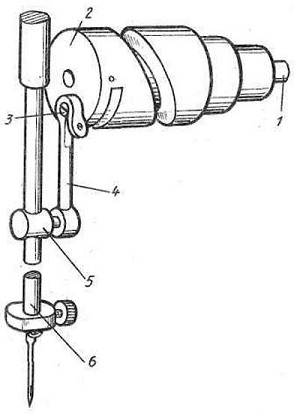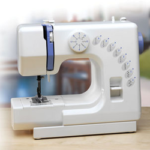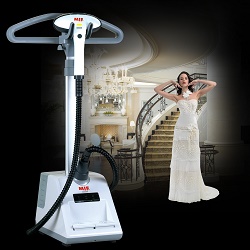How a sewing machine works and works
Initially, the sewing machine was designed in such a way that it could do the work on its own, thereby replacing the person. This invention has greatly facilitated the work of a seamstress, and increased his productivity. The scheme of work allows even an absolute beginner, never holding a needle in his hands, to sew straight and high-quality stitches. The latest generation of devices sews not only a simple way, they are able to create patterns and embroidery. The achievements of modern technologies are amazing, but the basis of the principle of operation of each sewing machine is still the very first algorithm developed many years ago.
Content
Scheme of the sewing machine
There are basic parts of the sewing machine, without which no aggregate can do:
- flywheel;
- winder;
- sleeve;
- sewing platform;
- stitch wheel;
- sleeve stand
- receiver (reverse)
- needle holder;
- needle plate;
- foot;
- lever for raising and lowering the foot.

But these are the details that are visible when viewed from the surface - they are a small fraction of the mechanism hidden under the body. Inside there is a complex system for activating the shuttle. We can say that the work of the sewing machine is entirely based on the shuttle device. For an unprepared person, the scheme of parts of a regular sewing machine may seem complicated and confusing, but everything becomes clear if you understand a little.
Bobbin
The bobbin is the most noticeable detail with which the tailor has a constant interaction. It is located for retractable needle panel. To get the bobbin out of the socket, pull it towards you and slightly upwards. This way you will bend back the small grip and release the element.

The bobbin is necessary for the supply of threads, which are wound from the main reel before working on it. This happens automatically - the thread from the spool is threaded into a special hole in the bobbin.After that, the item is placed in the slot, and the coil with threads is fixed on the body of the machine. When the flywheel is activated, the bobbin rotates, which winds the thread on its axis, while the spool of thread also rotates.

For thread tension during operation, the bobbin structure includes small screw. Competently set settings exclude the possibility of skipping upper and lower stitches. A tailor can sew without being distracted by constant quality checks. Carefully check the thread before starting work, its excessive tension causes permanent breaks. Watch the video about the perfect tension of the thread.

The little detail, the so-called spout, it is intended for the insurance of the coil against casual dropsouts of the bobbin. It is mounted on a moving panel, which is pressed by a spring mechanism from the sleeve body. If everything works as intended, then the system does not fail. While this part is in the correct position, the bobbin is securely fastened in the sewing machine and cannot be pulled out. To reverse the assembly, bend the spout, and, holding it in this position, insert the bobbin in place.
When studying the case on the sewing machine, you can find an oblong protrusion. His task is to prevent the rotation of the coil with a bobbin or a shuttle drive.

Shuttle
The bobbin inserted in place interacts with one of the main parts of the device, namely the shuttle. It is presented in the form of moving back and forth details, embedded in a special profile.

A working sewing machine drives it through connecting rodspecifying the correct trajectory.

The operation of the connecting rod can be controlled by the operator. For this purpose, a retractable metal panel is specially provided on the case. Unscrewing it, you can see how the flywheel rotates, setting in motion a needle that goes down and then up. At the lifting point, without reaching the table surface of five millimeters, a sharp grip passes by it.

This capture represents bow of the shuttle. The device of the sewing machine provides for a gap between this nose and the needle, not too large, but not small enough to allow them to accidentally touch.
Sometimes the distance starts to increase, and if its value changes by at least half a millimeter, the machine will start skipping stitches in the line.With such a failure, the needle continues its work, the fabric is well advanced, but the thread does not sew it at all. Holed matter is practically not fastened together and continues its movement. To eliminate this trouble, you need to adjust the position of the needle to the shuttle.
Video how to adjust the hook of the sewing machine from the company "Podolsk".
Sewing machine operation
How is the sewing machine, and what forces drive its internal processes? The basis of the entire system is the simplest principle based on a given movement of the needle. Taking the upper thread with her, she thread it down. Further, it is picked up by the shuttle already ready for this, and weaves the lower with the upper thread.
The simplest movement provides the basis for such complex manipulations as zigzag stitches and even patterned embroidery. Video on how to perform embroidery on a home sewing machine.
Manufacturing companies improve their models. Today, there are units with a special addition in the form of a side needle for processing the edges of matter, but finding them in simple stores is not easy.
The inner part of the housing hides the drive, which is actuated manually (in mechanical machines) or by an electric motor (in electromechanical devices). The engine through the connecting rod starts the rotation of the other three shafts. If we go into details, we can say that the system includes one intermediate axis, which transmits the rotational impulse to the three shafts described.
This system is designed for a long period of use and is considered to be quite durable. For the application of lubricants to moving parts, holes are provided in the housing into which the nozzle of the lubricator can easily pass.
Mechanisms mechanical sewing machines do not give in to fast wear, and their characteristics are considered as one of the best. With proper care, the device can last a tailor for up to fifty years without any problems. However, to do this, you must comply with all the prescribed cooking instructions before working, and also regularly gloss over and clean moving parts.
In more advanced models provides pedal, when pressed with a foot on which all the mechanisms are set in motion.It is much more convenient to use, as it gives freedom to hands. Of course, modern designers have perfected this system, turning the pedal from mechanical into electric.
Moving tissue
Speaking about how the home sewing machine works, it is impossible to omit the description of the device intended for pulling. This revolutionary for its time, the invention allowed to set the desired length of stitches, and also saved the tailors from the obligation to monitor the progress of the flap.
Everything happens as follows:
- in the first stage, the main shaft passes through the central part, which is connected to the flywheel axis through the connecting rod;
- in the side parts there are two rods, with synchronous rotation of which the drawing mechanism starts moving.
The first is equipped with a detail that experts call among themselves "Dovetail". For the common man, he looks more like a key. This element moves back and forth in the direction of the fabric.

The second axis has a cam, which is located in the “dovetail” space. Its main function is the ascent and descent of the part.
The final result of all movements of these mechanisms is the work of the sewing machine, the detail in the form of a “dovetail” is set in motion by the lingering teeth. Having gained momentum, the teeth perform their steps, scrolling in place.
All manipulations to adjust the stitch length is carried out by means of a rotary lever. Very small parts fastened with the axis of the tail key. When turning the lever, the tails change their configuration from the initial position, which leads to a change in the stitch length in the stitch. Video shows how to properly adjust the length of steps.
Thread tension
This manipulation is carried out using special screwlocated above the needle holder. The tension of the upper thread is an important indicator controlling the quality of the seam. Not far from the needle holder is a special eyelet that moves in the process of work and does not allow the tensioned thread to loosen or sag when the needle goes up. Without this small detail, the entire operation of the sewing machine would have come to naught.
Video on how to assemble and install a thread tension regulator.
Winding device
At the end of the description you need to say a few words about the device winding.As a rule, a small coil is located close to the flywheel. pressure wheel with shaft stocked with risk.
On the panel located under it, there is an eye with another small wheel. The coil is mounted on a vertical stand, and already from it the thread is passed over the table in order to be wound on a bobbin. To ensure proper operation, the pressure wheel is gently pressed with a finger, after which rotation begins, transmitted from the drive of the sewing machine.
The design provides another option. If the bottom thread suddenly ends, you can use the end, taken straight from the needle. The main thing, do not forget to pull it out of the ear. After that, repeat the algorithm described above.

/rating_off.png)












